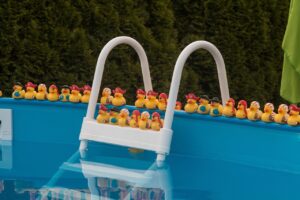Introduction to Indoor Swimming Pool Cleaning Tips

It is a luxury to have indoor swimming pools as you can swim any time of the year regardless of the weather. However, there are special cleaning requirements in indoor pools (as opposed to outdoor pools). Being in an enclosed environment, dirt, oils and chemicals can easily accumulate unless they are well maintained.
Here you will find out about cleaning and maintenance tips, helpful tricks of an expert to keep your indoor swimming pool clean, hygienic, and safe.
Why Indoor Swimming Pool Cleaning Is Important
A clean pool is a matter of appearance, health, safety and efficiency. That is why it is so important to clean up all the time:
- Kills even diseases of the bacteria and algae.
- Stays clear of water to take pleasure in swimming.
- Guards pool equipment.
- Improves the quality of the air inside the swimming pool (there is no acrid smell of chlorine)
- Costs less when compared to costly repairs over time.
Daily Indoor Pool Cleaning Checklist
To keep an indoor pool doesn’t need to be difficult when you adhere to a simple daily routine:
- Scrape the top of the water to get rid of floating debris (hair, dust, insects)
- Skimmer and pump basket empty.
- Test water level and replenish, as necessary.
- Measure pH and chlorine content of test water using pool test kit.
- Clean down pool tiles around the water areas to avoid accretion.
PRO TIP Although a pool inside a house does not attract leaves like an outdoor pool, dust and body oils are the biggest offenders. Skimming daily makes a big difference.
Weekly Indoor Pool Cleaning Routine
Take the time to do a deep clean once a week.
Vacuum the Pool Floor
- Use either an automated pool vacuum or manual.
- Pay attention to areas where debris usually accumulates.
Brush the Pool Walls
- Clean walls, ladders and steps with a pool brush.
- Prevent deposition of algae and calcium.
Shock the Pool
- Add chlorine shock to kill bacteria and restore the balance.
- Carefully follow the instructions on the shock product.
Check the Filter System
- Backwash sand or DE filters.
- Water spray clean cartridge filters.

Monthly Indoor Pool Maintenance Tasks
Be a bit more than usual once in a month:
- Check HVAC/ventilation systems – eliminates humidity problems and mould.
- Clean pool cover – wash and disinfect to kill bacteria.
- Check calcium hardness and alkalinity -checks balanced water.
- Service equipments – pumps, heaters, filters all affected by wear and tear should be examined.
Step-by-Step: How to Clean an Indoor Pool Manually
- Switch off pool machinery.
- Vacuum and clean off dirt.
- Use the brush walls and tiles with the appropriate brush (vinyl and concrete use nylon and steel respectively).
- Clean the water with a weak pool cleaner.
- Wet down deck and environment to avoid dust blowing into the water.
- Turn on filtration system again and allow to run several hours.
- Warm up the test water chemistry and make adjustments.
Indoor vs. Outdoor Pool Cleaning: Quick Comparison
| Feature | Indoor Swimming Pool | Outdoor Swimming Pool |
| Exposure to debris | Low (no leaves, dirt) | High (leaves, dust, insects) |
| Sunlight impact | Minimal (indoors) | High (algae growth from sunlight) |
| Chlorine usage | Lower (less UV breakdown) | Higher (UV breaks down chlorine) |
| Air quality concern | Yes (needs ventilation) | No (open air circulation) |
Common Indoor Pool Cleaning Mistakes to Avoid
- Overlooking ventilation systems: results in humidity and mold.
- Excess chlorine use: results in headaches and irritation of the eyes.
- Missing wall brushing: means algae and scale can develop.
- Failure to cover the pools with covers: dirty covers bring in bacteria once again.
- Failure to regularly test water: means that chemical imbalance destroys pool surfaces.

Eco-Friendly Indoor Pool Cleaning Tips
Try these:
- Use saltwater chlorination system to minimize use of chlorine.
- Install natural disinfection UV or Ozone sanitizers.
- Use baking soda to clean tiles, rather than cleaning chemicals.
Frequently Asked Questions (FAQs)
1. How often should I clean my indoor swimming pool?
- Daily: Scan water surface and water test.
- Weekly: Vacuum, brush, shock treatment.
- Check equipment and deep clean monthly.
2. Do indoor pools need chlorine?
Yes. Although they are indoors, the development of bacteria still occurs. Yet, indoor pools tend to use less chlorine when compared to outdoor pools.
3. Can I use household cleaners for pool cleaning?
No. Pool surfaces can be damaged by regular household cleaners or can change the water chemistry. Cleaning products should be pool safe.
4. How do I reduce the strong chlorine smell indoors?
Enhance ventilation and prevent over chlorinating. A UV system also leads to a reduction in chloramines, which cause strong odours.
5. What’s the best way to prevent mold in indoor pool areas?
Install a dehumidifier, be sure that you have proper ventilation, and wipe down walls and ceilings around the pool on a regular basis.
Conclusion
Indoor swimming pools make a very nice investment, as they require regular maintenance to remain safe, clean and fun. With proper routines of cleaning the pool on a daily, weekly, and monthly basis and taking precautions to prevent frequent errors, your pool can remain crystal clean.
Note to self: prevention is cheaper than a cure. Cleaning keeps your equipment and pool in top shape, and not only costs less.

